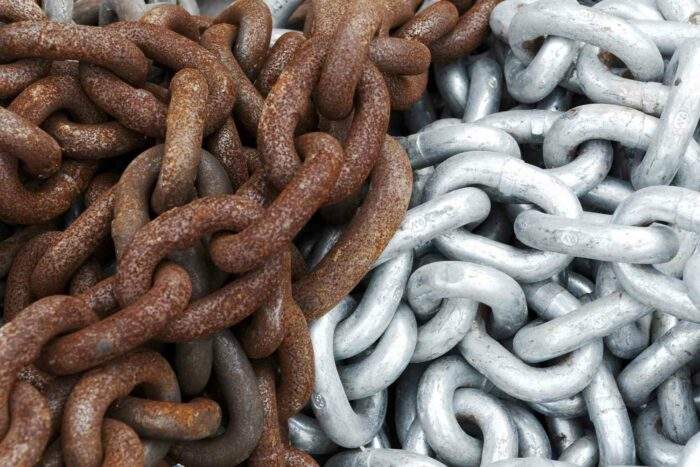Prevention of corrosion of metals
Preventing corrosion of metals is a critical task, especially given the importance of metals in our daily lives.

Understanding Corrosion: A Key to Prevention
Corrosion is the gradual deterioration of metal caused by the reaction of metal with the environment, leading to the formation of rust, tarnish, or other types of corrosion products. To prevent corrosion, it’s essential to understand the type of corrosion, its causes, and its effects on the metal.
Some common types of corrosion include galvanic corrosion, pitting corrosion, and crevice corrosion. Understanding the corrosive environment, the metal’s properties, and the potential risks of corrosion is critical in selecting the right prevention methods.
Surface Protection Techniques for Prevention of corrosion of metals
Surface protection techniques are used to prevent the corrosive environment from coming into contact with the metal. Some of the commonly used surface protection techniques include painting, powder coating, anodizing, and plating.
These methods create a barrier between the metal and the environment, preventing the metal from corroding. Surface protection techniques must be carefully chosen based on the type of metal, the corrosive environment, and the desired level of protection.
Cathodic Protection: An Effective Method Prevention of corrosion of metals
Cathodic protection is an electrochemical technique used to prevent corrosion of metal structures. This method involves connecting the metal structure to a sacrificial anode, which corrodes instead of the metal structure, protecting it from corrosion.
Cathodic protection is commonly used in underground pipelines, ship hulls, and offshore structures. This method is effective in preventing corrosion in aggressive environments where other protection methods may not be effective.
Choosing the Right Materials for Corrosion Resistance
Choosing the right materials is an essential aspect of preventing corrosion. Some materials are inherently resistant to corrosion, while others are not. For example, stainless steel is highly resistant to corrosion due to the presence of chromium in the alloy. Choosing the right material based on the corrosive environment, the metal’s properties, and the desired level of protection is critical in preventing corrosion.
Proper Maintenance and Inspection for Corrosion Prevention
Proper maintenance and inspection of metal structures are critical in preventing corrosion. Regular cleaning, painting, and coating are essential in maintaining the protective barrier on the metal surface. Inspection can detect early signs of corrosion, allowing for timely maintenance and repair.
Additionally, ensuring proper drainage, ventilation, and humidity control can prevent the accumulation of moisture, a leading cause of corrosion. Read More Blogs like this only on this website Proper maintenance and inspection can extend the lifespan of metal structures, reduce repair costs, and prevent catastrophic failure.
Prevention of corrosion of metals in future
Preventing corrosion of metals in the future is a critical task, especially given the importance of metals in our daily lives. Here are some potential approaches for preventing corrosion of metals in the future:
Advanced materials:
Researchers are continuously developing advanced materials that are more resistant to corrosion. For example, new types of stainless steel and titanium alloys have been developed that offer higher corrosion resistance than traditional materials. These materials can be used in harsh environments to reduce corrosion rates and extend the lifespan of metal structures.
Protective coatings:
New types of protective coatings are being developed that can provide even better protection against corrosion. These coatings can be applied to the surface of the metal and create a barrier between the metal and the environment, preventing the metal from corroding. Some of these coatings can even self-heal in the presence of minor damage, providing longer-lasting protection.
Corrosion inhibitors:
Corrosion inhibitors are chemical compounds that can be added to the metal or the environment to slow down or stop corrosion. These compounds work by reacting with the metal surface or forming a protective film on the surface of the metal. In the future, more effective corrosion inhibitors could be developed that provide better protection against corrosion.
Design modifications:
By modifying the design of metal structures, it is possible to reduce the likelihood of corrosion. For example, adding drainage channels or using more durable coatings can help to prevent water from accumulating on the surface of the metal, reducing the risk of corrosion.
Improved maintenance:
Regular maintenance of metal structures is critical in Preventing corrosion of metals. In the future, new maintenance strategies could be developed that are more effective at preventing corrosion. For example, using automated inspection tools or predictive analytics to identify potential corrosion risks could help to early and prevent further damage.
Conclusion
Prevention of corrosion of metals in the future will require a combination of advanced materials, protective coatings, corrosion inhibitors, and improved maintenance strategies. By adopting these approaches, we can ensure that metal structures remain durable, reliable, and safe for many years to come.




